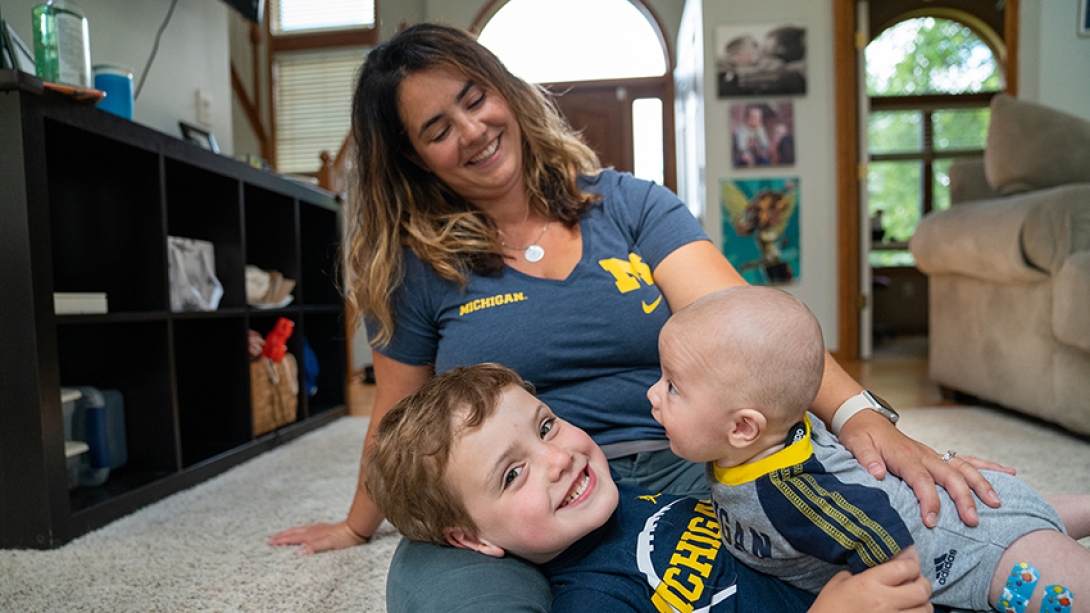Michigan Medicine performed the state’s first spina bifida fetal surgery in 2014 – and today, that baby is a running, dancing, active five-year-old.
9:30 AM
Author |
Carter Hilton spent a recent day dancing around his living room to "Raining Tacos," riding his bike across the lawn and playing catch with his mom while racing up and down stairs.
Not the picture his parents had imagined when they learned during pregnancy that Carter had a spinal cord defect called spina bifida, which means "split spine."
"We didn't know if he would ever be able to walk," his mom Kasey Hilton says. "But he proved us wrong. Now we have a hard time keeping up with him."
The junior kindergartner recently celebrated his fifth birthday, which also represents a local medical milestone. Carter was the first baby in Michigan to undergo a specialized fetal surgery to repair spina bifida – while he was still in the womb.
And since Carter's case in 2014, Michigan Medicine has performed roughly 20 similar surgeries that aim to improve long term outcomes for children with the condition.
"We have continued offering this procedure because of the benefits we are seeing for our patients," says Marjorie Treadwell, M.D., director of Michigan Medicine's Fetal Diagnosis and Treatment Center and a high-risk maternal fetal medicine physician at Von Voigtlander Women's Hospital and C.S. Mott Children's Hospital.
"It's important for families to understand that this is a treatment, not a cure. There are no guarantees, but research shows that this fetal surgery has the potential to improve a child's outcomes later in life. To see Carter today five years later, running around and such a bundle of energy, it reinforces why we do what we do."
A pea-sized protrusion
Kasey Hilton, a fifth grade teacher and husband Mike, a chiropractor, were highly anticipating the 20-week ultrasound of their first baby in 2014.
The biggest surprise the Brighton couple was expecting: learning their newborn's gender.
MORE FROM MICHIGAN: Sign up for our weekly newsletter
They learned that they were having a boy. But the ultrasound revealed something else – a pea-size protrusion on the spine of the fetus.
During early fetal development, the spine comes together like a zipper covering the spinal cord and nerves. In Carter's case, the backbone and spinal cord didn't fuse properly, leaving an incomplete closure.

Further tests confirmed that Carter had the most severe form of spina bifida, known as myelomeningocele. This meant a sac of fluid had come through the opening in his back, increasing the risk that part of the spinal cord and nerves were damaged.
About 1,500 babies are born in the U.S. each year with spina bifida, according to the U.S. Centers for Disease Control and Prevention. The condition is associated with long term disability, including bowel and bladder dysfunction and the possibility of not being able to walk independently.
For years, standard treatment involved neurosurgery to repair the defect after a baby was born. But in 2011, the multicenter Management of Myelomeningocele Study (MOMS) indicated that some children could benefit from the repair being done in-utero.
After being referred from nurse midwifery services to Michigan Medicine's maternal fetal medicine team, the Hiltons learned, through a multitude of tests, that they were candidates for the procedure.
There were caveats: The surgery came with risks to both mom and baby. The recovery period would be painful and possibly require a weeklong hospital stay. There would be immediate lifestyle changes and limitations for Kasey who would also have a large scar on her abdomen.
Lastly, it had never been done in Michigan.
"When Dr. Treadwell told me I would be their first case, it was definitely a little nerve-wracking, but we knew we had to try it," Kasey says. "If this surgery could give Carter a better chance of having a better outcome, then that's what we were going to do. I would do it all over again in a heartbeat."
Operating on a 1-pound fetus
On July 29, 2014, at 23 and a half weeks pregnant, Kasey entered an operating room with a highly trained team of Michigan Medicine maternal fetal medicine physicians, neurosurgeons, anesthesiologists and nurses.
One anesthesiologist was responsible for Kasey. A second anesthesiologist worked with a pediatric cardiologist and maternal fetal medicine doctor to monitor the fetus, which was separately anaesthetized.
Doctors opened Kasey's abdomen and uterus and gently reached in to bring the fetus up to the incision without actually removing it from the uterus. They then positioned the roughly single-pound fetus to work on its tiny spine. A pediatric neurosurgeon carefully separated some of the abnormal tissue, covering the protrusion with multiple layers of the fetus's own tissue.
He then closed the skin over the spine, careful not to disturb underlying nerve tissue.
This decision was the best one for him and we feel lucky that we had this option. He has exceeded all expectations, and I'm sure he will just continue to keep us on our toes.Kasey Hilton
The team then sewed the abdomen back up – ensuring stitches on the uterus were water-tight so that the amniotic fluid didn't leak out. The fetus went back to developing for several more months.
Families like the Hiltons have a special name for their baby's fetal surgery.
"We call it his 'sneak peek' day, He wasn't ready to come out yet, but we got a sneak peek," Kasey says with a laugh. "We celebrate it every year because it's such a big day in our lives. It's like he gets two birthdays."
Exceeding all expectations
Carter surprised everyone when he started walking before age two.
"We were shocked. It was so much earlier than we had expected. His legs are so strong," Kasey says. "But once he started, he never stopped."
Still, Carter does require physical therapy and uses braces to support his legs throughout the day. When he was two months old, he had brain surgery to have a shunt placed to help relieve the excess fluid (hydrocephalus) in his ventricles, which is common for people with spina bifida.
He may also need foot surgery down the road to help keep one of his ankles straight. There are urological challenges as well that are addressed through care at Michigan's Spina Bifida Clinic.
None of that has stopped him from enjoying an active childhood. Today, the five-year-old described as having a "strong personality" enjoys swimming, dancing, baseball, dinosaurs and watching University of Michigan football games with his dad. This year, he also became a big brother to Colton, six months.

"As he gets older he's noticing he has some differences from other kids but he has really been thriving and is just loving life," Kasey says. "We are so proud of the little boy he is and the obstacles he's already overcome.
"This decision was the best one for him and we feel lucky that we had this option. He has exceeded all expectations, and I'm sure he will just continue to keep us on our toes."
A Life-Changing Second Opinion
Just months after Carter's birth, Michigan Medicine heard from another family interested in the same procedure.
Erica and Jim Hopp had waited more than 12 years to have a baby of their own.
So it came as a big surprise when Erica became pregnant two years after stopping fertility treatment.
But at an ultrasound near their home in Gaylord, the couple learned that their baby boy had the most severe form of spina bifida. Options were limited.
"It was very discouraging," Erica recalls. "We were told that he would be paralyzed and likely have an extremely low quality of life."
Only through her own online research did she come across the MOMS study – and learn that Michigan Medicine was among select sites in the country offering a novel fetal procedure for spina bifida.
LISTEN UP: Add the new Michigan Medicine News Break to your Alexa-enabled device, or subscribe to our daily updates on iTunes, Google Play and Stitcher.
In 2015, Erica Hopp became the second expectant mom to undergo the fetal surgery at Michigan.
Today, 4-year-old Jackson Hopp is described as a "dance machine" with a keen curiosity and "contagious spark." The preschooler walks and runs without any assistance.
"We were watching him dance in the living room the other day and talking about how happy we were that we got a second opinion," Erica says.
"We are just so thankful. Thankful that we had the opportunity to do this procedure and for all of the doctors and teams at Michigan who took care of us."
A couple of years ago, Erica initiated an annual camping trip to unite families touched by spina bifida or fetal surgery. And Jackson loves sharing the story of the surgery he had before birth, proudly showing off the scar on his back.
"It was definitely one of the most difficult things I've ever done, emotionally and certainly physically," Erica says of the procedure. "I would still do it all over again. Even if he didn't end up having the amazing outcome that he did, we wanted to know we did everything we possibly could to give him the best life."

Explore a variety of healthcare news & stories by visiting the Health Lab home page for more articles.

Department of Communication at Michigan Medicine
Want top health & research news weekly? Sign up for Health Lab’s newsletters today!





